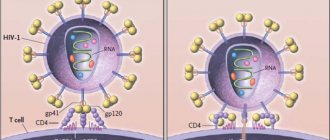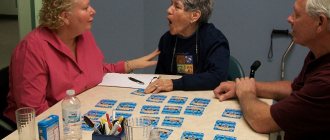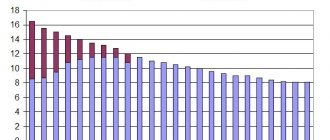The brain is a powerful control center that sends commands throughout the body and controls the progress of their implementation. It is thanks to him that we perceive the world and are able to interact with it. The kind of brain a modern person has, his intelligence, thinking, are the result of millions of years of continuous evolution of mankind, his structure is unique.
The brain is characterized by division into zones, each of which specializes in performing its own specific functions. It is important to have information about what functions each zone performs. Then you can easily understand why specific symptoms appear in such common diseases as Parkinson’s disease, Alzheimer’s disease, stroke, etc. Disorders can be regulated with medication, as well as with the help of special exercises and physical procedures.
The brain is structurally divided into:
- rear;
- average;
- front.
Each of them has their own role.
In an embryo, the head develops faster than other parts of the body. In a one-month-old embryo, all three parts of the brain can be easily seen. During this period they look like “brain bubbles”. The brain of a newborn is the most developed system in his body.
Scientists attribute the hindbrain and midbrain to more ancient structures. It is this part that is entrusted with the most important functions - maintaining breathing and blood circulation. The boundaries of their functions are clearly separated. Each gyrus does its job. The more pronounced the groove became during development, the more functions it could perform. But the anterior section provides everything that connects us with the external environment (speech, hearing, memory, ability to think, emotions).
There is an opinion that a woman's brain is smaller than a man's brain. Data from modern hardware studies, in particular on a tomograph, have not confirmed this. This definition can easily be called erroneous. The brain of different people may differ in size and weight, but this does not depend on gender.
Knowing the structure of the brain, you can understand why certain diseases appear and what their symptoms depend on.
Structurally, the brain consists of two hemispheres: right and left. Outwardly, they are very similar and are interconnected by a huge number of nerve fibers. Each person has one side that is dominant, right-handers have the left side, and left-handers have the right side.
There are also four lobes of the brain. You can clearly see how the functions of the shares are differentiated.
Frontal
These lobes have a frontal location, they occupy the forehead area. Let's figure out what the frontal lobe is responsible for. The frontal lobes of the brain are responsible for sending commands to all organs and systems. They can be figuratively called a “command post.” It would take a long time to list all their functions. These centers are responsible for all actions and provide the most important human qualities (initiative, independence, critical self-esteem, etc.). When they are defeated, a person becomes carefree, changeable, his aspirations have no meaning, he is prone to inappropriate jokes. Such symptoms may indicate atrophy of the frontal lobes, leading to passivity, which is easily mistaken for laziness.
Each lobe has a dominant and auxiliary part. For right-handed people, the left area will be dominant and vice versa. If you separate them, it is easier to understand which functions are assigned to a specific area.
It is the frontal lobes that control human behavior. This part of the brain sends commands that prevent a specific antisocial action from being performed. It is easy to notice how this area is affected in dementia patients. The internal limiter is turned off, and the person can tirelessly use obscene language, indulge in obscenities, etc.
The frontal lobes of the brain are also responsible for planning, organizing voluntary actions, and mastering the necessary skills. Thanks to them, those actions that seem very difficult at first become automatic over time. But when these areas are damaged, the person performs the actions as if anew each time, and automaticity is not developed. Such patients forget how to go to the store, how to cook, etc.
When the frontal lobes are damaged, perseveration can occur, in which patients literally become fixated on performing the same action. A person may repeat the same word, phrase, or constantly move objects around aimlessly.
The frontal lobes have a main, dominant, most often left, lobe. Thanks to her work, speech, attention, and abstract thinking are organized.
It is the frontal lobes that are responsible for maintaining the human body in an upright position. Patients with their lesions are distinguished by a hunched posture and a mincing gait.
How does the brain work?
Left-handedness is one of the variants of the development of the body, associated with the peculiarities of the functioning of the brain. In left-handed people, interhemispheric interaction and hemispheric specialization are not primarily formed.
Each hemisphere of the brain has its own role.
The left hemisphere is called rational-logical. It controls logical, analytical, abstract thinking. processes information sequentially, progressively, going through all possible options. The left hemisphere is mainly responsible for the right side of the body: it receives information from the right eye, ear, right arm, and leg. The right hemisphere is called the emotional hemisphere. It is responsible for imaginative thinking, perception of art, imagination. The right hemisphere processes information simultaneously, instantly perceiving a holistic image; our ability for emotional perception, synthetic thinking, intuition, and visual-spatial functions rely on it. The right hemisphere serves the left side of the body.
Usually, by the age of 4-5, children develop a leading hand, eye, and ear . The leading left hand (ear, eye) indicates the activity of the right hemisphere. Until this point, children can pick up objects, hold a spoon, draw, cut out, etc. first with one hand, then with the other. Their hemisphere dominance has not yet been established. It is important at this time not to insist that the child perform actions with one hand; when dominance is established, this will happen naturally.
Temporal
They are responsible for hearing, turning sounds into images. They provide speech perception and communication in general. The dominant temporal lobe of the brain allows you to fill the words you hear with meaning and select the necessary lexemes in order to express your thoughts. The non-dominant helps to recognize intonation and determine the expression of a human face.
The anterior and middle temporal regions are responsible for the sense of smell. If it is lost in old age, it may signal incipient Alzheimer's disease.
The hippocampus is responsible for long-term memory. It is he who stores all our memories.
If both temporal lobes are affected, a person cannot assimilate visual images, becomes serene, and his sexuality goes through the roof.
Synchronous work
The functioning of the whole brain is important for a person. Both hemispheres are needed equally. The left hemisphere allows you to simplify the world and analyze what is happening, and the right hemisphere allows you to perceive the world as it is in reality. Without the right hemisphere, we would all become calculating and emotionless machines, adapting this world to suit our life activities. When a person knows what the left hemisphere of the brain is responsible for, he can apply some techniques to improve its functioning. This will allow you to develop certain abilities. In order to determine which hemisphere is better developed, there are a number of tests that people can do on their own. In the left hemisphere, priority is given to dry calculations, here feelings are not taken into account. Thus, when communicating with another person, an individual reads dry facts in order to analyze his behavior, but the right side of the brain also functions synchronously. She analyzes a person on a non-verbal level and intuitively. Thus, we get the most complete picture of who he communicates with.
Also, the left hemisphere allows you to perceive and understand notes, is responsible for hearing music, and the right hemisphere makes it possible to perceive the beauty of music, its melody, which once again proves how synchronously and harmoniously the human brain works. This is a truly powerful computer that endlessly processes a huge amount of information. But at the same time it is very fragile, it is practically impossible to recover from injuries. This is why they say you should never hit children on the head. And an adult needs to be very careful not to damage it. It is in this small organ that a person’s whole life is contained, the understanding of who he is in this world and that he is part of this world.
Parietal
In order to understand the functions of the parietal lobes, it is important to understand that the dominant and non-dominant side will do different jobs.
The dominant parietal lobe of the brain helps to understand the structure of the whole through its parts, their structure, order. Thanks to her, we know how to put individual parts into a whole. The ability to read is very indicative of this. To read a word, you need to put the letters together, and you need to create a phrase from the words. Manipulations with numbers are also carried out.
The parietal lobe helps to link individual movements into a complete action. When this function is disrupted, apraxia is observed. Patients cannot perform basic actions, for example, they are not able to get dressed. This happens with Alzheimer's disease. A person simply forgets how to make the necessary movements.
The dominant area helps you feel your body, distinguish between the right and left sides, and relate parts and the whole. This regulation is involved in spatial orientation.
The non-dominant side (in right-handed people it is the right side) combines information that comes from the occipital lobes and allows you to perceive the world around you in three-dimensional mode. If the non-dominant parietal lobe is disrupted, visual agnosia may occur, in which a person is unable to recognize objects, landscapes, or even faces.
The parietal lobes are involved in the perception of pain, cold, and heat. Their functioning also ensures orientation in space.
Features of left-handers
Left-handed people demonstrate, on the one hand, higher creative abilities (the rigidity of established connections can contribute to more standard thinking), and on the other hand, they demonstrate a slower formation of skills in activities that require the interaction of both hemispheres compared to right-handed people.
Study of the emotional sphere : right-handed people show greater sensitivity to positive emotions, and left-handed people and ambidextrous people are characterized by a predominance of negative emotions, that is, they are more pessimistic. Research conducted at the University of Michigan (according to I. Makaryev) revealed that left-handed people have a predominance of such indicators of temperament such as anger (emotional incontinence), fear (timidity), low mood, comfort, conscientiousness, timidity, aesthetic sensitivity, sensuality, increased level of anxiety.
According to a number of psychologists, left-handers experience particular difficulties adapting to school. According to some authors, the percentage of various kinds of left-handers among children with learning problems is at least 2.5 times higher than the average figures for right-handers.
The usual problems of a left-handed child are persistent difficulties in remembering the direction of the clock hands, determining “left”, “right”, and sometimes “above”, “below”.
In a left-handed world, you can read or write a letter or number with equal probability in any direction (both horizontal and vertical). Accordingly, this extends to more complex actions: reading, writing, counting, remembering, interpreting a plot picture can be started from any side (including from bottom to top). When drawing, for example, a child is not able to adequately distribute the space of the sheet of paper lying in front of him: his drawings creep on top of each other, although there is enough free space around him. The fact is that the starting point for mastering these skills is visual perception.
Impaired or insufficient development of visual-spatial perception, visual memory and hand-eye coordination, often found in left-handed people, leads to the following difficulties:
- perception and memorization of complex letter configurations when reading and a correspondingly slow pace;
- formation of a visual image of letters and numbers (violation of the correlation of elements, the child confuses letters and numbers with similar configurations, writes extra elements or does not complete elements of letters and numbers);
- highlighting and distinguishing geometric shapes, replacing similar shapes (circle - oval, square - rhombus - rectangle);
- copying;
- unstable handwriting (uneven strokes, large, stretched, differently angled letters);
- mirror writing of letters, numbers, graphic elements;
- very slow pace of writing.
with the phenomenon of mirror movements . For some, it manifests itself in the form of mirror writing (the child begins to write with the letter that ends the word, then writes the penultimate one, etc., so if you put a mirror to a written word, you will see the word written in the traditional way in a mirror image ), but there are also mirror reading, mirror drawing, mirror perception.
If, after 10 years, manifestations of mirror perception persist, then it is recommended to conduct a thorough analysis of the type of mirror movements, their causes, and organize special classes that correct deficiencies in spatial perception, coordination, attention, and self-testing skills.
Along with mirror writing, mirror drawing is often observed in children . Inversion is especially characteristic when drawing: top and bottom, vertical and horizontal, right and left change places, and the child does not feel the wrongness.
Left-handers also face enormous difficulties when determining the time on a dial. They not only mirror one or both hands, but also make metric errors - they determine the time with a difference of 10-15 minutes (this also applies to the hour hand).
Typically, most left-handers experience distortions and delays in the development of speech (oral and written), reading, counting, constructive processes, and emotions.
It is important that all these disproportions increase with unqualified retraining of children.
Almost all left-handed children have colossal, almost mystical voluntary control over their mental activity . In many cases, they achieve the desired results in a roundabout way, sometimes finding the most unimaginable external or internal means. Moreover, each time this process is simply unpredictable.
A left-handed child seems to invent his own way of mastering the world of right-handed people every time. At the same time, he has to “pass everything over his head.” And neuropsychologists know that the human brain is an amazingly perfect and subtle instrument, but it also has a finite amount of energy in each specific case. The more energy required for higher mental processes (thinking, speech, counting), the greater the likelihood of “robbing” the basal structures of the psyche (emotional, somatic and others).
It is precisely this mechanism that is often observed in left-handers. If any child requires attention in this sense, then a left-handed child requires three times more attention.
Occipital
The occipital lobes process visual information. It is with these lobes of the brain that we actually “see.” They read signals that come from the eyes. The occipital lobe is responsible for processing information about shape, color, and movement. The parietal lobe then turns this information into a three-dimensional image.
If a person stops recognizing familiar objects or loved ones, this may indicate a dysfunction in the occipital or temporal lobe of the brain. In a number of diseases, the brain loses the ability to process received signals.
"Eye" symptoms as signs of brain damage
At present, the problems of brain diseases with a tendency to a progressive course remain relevant, and since the eye is part of the nervous system apparatus, disturbances in the regulation of blood circulation and subsequent brain hypoxia are risk factors for the occurrence and development of ocular ischemic syndrome. The ophthalmic artery is the first intracranial branch of the internal carotid artery (ICA), which largely determines its participation in the blood supply to the brain. Pathological changes in the extracranial and intracranial segments of the great vessels negatively affect not only the blood circulation parameters of the cerebral vessels, but also aggravate disturbances in the blood circulation parameters of the eye vessels, which leads to the progression of ocular ischemic syndrome. W. Gowers in 1875 was the first to associate the appearance of right-sided hemiplegia and blindness in the left eye with unilateral occlusion of the ICA, which marked the beginning of the study of the problem of vascular lesions of the brain. Pathology of the ICA can be accompanied by circulatory disorders not only in the ICA itself, but also in the basin of its branches involved in the blood supply to the structures of the eye. ICA stenosis can manifest itself with a spectrum of “ocular” symptoms, so patients with ICA pathology may seek medical help from an ophthalmologist for the first time. Detection of hemorrhages in the retina in a patient with clinical signs of acute circulatory disorders (ACI) allows us to consider the process as a developed hemorrhagic stroke. With hemorrhage, along with hemorrhagic foci in the retina, blood may appear in the anterior chamber of the eye in the vitreous body (Terson syndrome). A dynamic disturbance of blood flow in the ICA proximal to the origin of the ophthalmic artery is manifested by a Petzl vascular crisis. With it, on the side of the hemodynamic disorder, a short-term visual impairment occurs - transient mononuclear blindness, and on the opposite side - paresthesia. The formation of a lesion in the basin of the middle cerebral artery is accompanied by Prevost’s symptom – gaze paresis caused by damage to the cortical “gaze center”. In 1952, M. Fisher described patients with transient mononuclear blindness and subsequent contralateral hemiparesis. Clinical lesions of the vertebrobasilar system may have periodic episodes of diplopia and strobism, in combination with other signs of damage to the brain stem or cerebellum, usually indicate the development of vascular crises in the patient as a transient ischemic attack in the vertebrobasilar system. Neuritis is characterized by a rapidly developing decrease in visual acuity with parallel changes in the fundus.
The degree of decrease in visual acuity depends on the intensity of inflammation and the degree of damage to the papillomacular bundle. The more it is affected, the more sharply the visual acuity is reduced. Changes in visual fields during neuritis are characterized by concentric narrowing and the presence of positive central scotomas. The narrowing of the visual fields can be uniform or uneven, which is also influenced by the localization and severity of inflammation. With neuritis, central scotomas are recorded less frequently than with retrobulbar neuritis. With retrobulbar neuritis, vision usually decreases significantly and quickly - within a few hours. More often, one eye is affected; there may be pain in the eye, and mild exophthalmos may be observed.
With the development of an infarct focus at the base of the brain stem at the level of the pons, most often caused by occlusion of the paramedian branches of the basilar artery (BA), the development of “locked-in man” syndrome, or ventral pontine syndrome or blocking syndrome - tetraplegia, pseudobulbar palsy and side gaze paralysis is possible with preserved consciousness and normal electroencephalogram. Also, if hemodynamics in the brain stem are impaired, Hertwig–Magendie syndrome is possible. This is a special form of strabismus, in which the eyeball on the affected side is turned downward and inward, and the other is turned upward and outward. Thrombosis of asthma is characterized by diplopia and oculomotor disorders, the nature of which is determined by the zone of formation of the ischemic focus in the brain stem; gaze paralysis is observed in the direction of the ischemic focus that has arisen in the pons.
Occlusion of the BA bifurcation by an embolus or thrombus causes ischemia in the basin of both posterior cerebral arteries; this process is characterized by blindness in both eyes or bilateral hemianopsia with possible preservation of central tubular vision. With hemodynamic disorders in the hypothalamic-mesencephalic region, Lhermitte's peduncular hallucinosis sometimes occurs: peculiar visual hallucinations of a hypnotic type. Visual hallucinations in cerebrovascular pathology can occur with a stroke in the basin of the branches of the posterior cerebral arteries. With high intracranial pressure as a result of compression of the cavernous or sigmoid sinus, the outflow from the orbital venous sinus may be impaired, which leads to the development of exophthalmos and other oculomotor disorders. During epilepsy with simple absence seizure, the patient freezes in the same position with a frozen gaze, sometimes rhythmic twitching of the eyeballs or eyelids, dilated pupils are observed, visual seizures are characterized by false perceptions, in some cases there is a paroxysmal appearance of scotoma.
The analyzed data allow us to draw the following conclusion: the issues of etiology, pathogenesis and diagnosis of ocular ischemic syndrome are being actively studied, but there is no consensus on the nature of this disorder. Improving and increasing the information content of neurophysiological diagnostic methods becomes important to clarify the role of damage to the vascular system of the brain in ocular ischemic syndrome. To establish the etiology, pathogenesis and course of ocular ischemic syndrome, it is important to carefully conduct a comprehensive examination in combination with special studies, including color Doppler mapping of extracranial and intracranial segments of the great vessels and the eye. In addition, magnetic resonance imaging with tractography and multislice computed tomography with contrast of extracranial vessels are of great importance in the study to identify and monitor the dynamics of cerebral ischemia in combination with ocular ischemic syndrome. A correlation was revealed between the degree of damage to the great vessels, the duration of the pathological process and the presence, degree and depth of ischemic damage to the organ of vision, in particular, reflected in a decrease in visual functions. Optimization of the diagnostic algorithm, identification of the relationship between the severity and time of manifestation of various clinical forms, on the one hand, and the degree of cerebrovascular insufficiency, on the other, will most likely lead to clarification of the indications for surgical intervention on the carotid arteries with the expected effect not only in the form of prevention of the disorder cerebral circulation, but also recovery from attacks of transient blindness and the absence of progressive loss of vision. Thus, in our opinion, today “eye” symptoms as signs of brain damage include retinal hemorrhages; the appearance of blood in the anterior chamber of the eye in the vitreous body (Terson syndrome); transient mononuclear blindness; gaze paresis caused by damage to the cortical “gaze center” (Prevost’s symptom); diplopia and strobism; paralysis of gaze to the side with preserved consciousness; strabismus, in which the eyeball on the affected side is turned downward and inward, and the other is turned upward and outward (Hertwig-Magendie syndrome); diplopia and oculomotor disorders; blindness in both eyes or bilateral hemianopsia with possible preservation of central tubular vision.
Conclusion
So, each department has its own functional load. If a separate lobe suffers due to injury or disease, another zone may take over some of its functions. Psychiatry has accumulated a lot of evidence of such redistribution.
It is important to remember that the brain cannot function fully without nutrients. The diet should have a variety of foods from which the nerve cells will receive the necessary substances. It is also important to improve blood supply to the brain. It is promoted by sports, walks in the fresh air, and a moderate amount of spices in the diet.
If you want to maintain full brain function until old age, you should develop your intellectual abilities. Scientists note an interesting pattern - people with intellectual work are less susceptible to Alzheimer's and Parkinson's diseases. The secret, in their opinion, lies in the fact that with increased brain activity in the hemispheres, new connections are constantly created between neurons. This ensures constant tissue development. If a disease affects one part of the brain, its functions are easily taken over by the neighboring zone.
The left hemisphere thinks logically.
The right helps to create new things, generate ideas, as it is now fashionable to say. However, you can be a mathematician with a well-developed left hemisphere and still not invent anything new. Or you can be a creator and throw out ideas left and right and not implement any of them due to the inconsistency and illogicality of your actions. Such people also exist. And they only lack one thing: working on improving their brain, bringing it into a harmonious state. Meanwhile, psychophysiologists have long developed a system of exercises for this. Music is good in this regard, for example, for pianists. They were already made harmonious from early childhood. After all, the most important tool for brain development is your hands. Acting with two hands, a person develops both hemispheres.
So, let's move on to the exercises. Many of them are well known to us from childhood. 1. “Ear-nose.” With our left hand we take the tip of the nose, and with our right hand we take the opposite ear, i.e. left. At the same time, release your ear and nose, clap your hands, change the position of your hands “exactly the opposite.” I tried it, it worked better when I was a child. 2. “Mirror drawing.” Place a blank sheet of paper on the table and take a pencil. Draw mirror-symmetrical designs and letters with both hands at the same time. When doing this exercise, you should feel your eyes and hands relax, because when both hemispheres work simultaneously, the efficiency of the entire brain improves. 3. "Ring". We move our fingers one by one and very quickly, connecting the index, middle, ring, and little fingers into a ring with the thumb. First, you can do it with each hand separately, then with both hands simultaneously.
Now let's remember physical education lessons. No wonder we were forced to do exercises in which we had to reach our right leg with our left hand and vice versa. They also develop our hemispheres and help them work in harmony.
Neurolinguistic programming, abbreviated NLP, is remarkably helpful in developing the hemispheres of the brain. I liked one of the NLP techniques called “First Aid”.
It helps relieve emotional stress, improves performance, develops attention, thinking and interhemispheric connections. This exercise is difficult and yet interesting.
I explain the procedure. In front of you lies a piece of paper with the letters of the alphabet, almost all of them. Under each letter the letters L, P or V are written. The upper letter is pronounced, and the lower letter indicates movement with the hands. L - the left hand rises to the left side, P - the right hand rises to the right side, V - both hands rise up. Everything is very simple, if only it weren’t so difficult to do it all at the same time. The exercise is performed in sequence from the first letter to the last, then from the last letter to the first. The following is written on the piece of paper.









